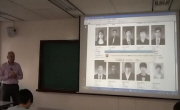<P><B>Significance</B></P><P>We report an electrically tunable graphene quantum switch based on Dirac fermion optics (DFO), with electrostatically defined analogies of mirror and collimators utilizing angle-dependent Klei...
http://chineseinput.net/에서 pinyin(병음)방식으로 중국어를 변환할 수 있습니다.
변환된 중국어를 복사하여 사용하시면 됩니다.
- 中文 을 입력하시려면 zhongwen을 입력하시고 space를누르시면됩니다.
- 北京 을 입력하시려면 beijing을 입력하시고 space를 누르시면 됩니다.
https://www.riss.kr/link?id=A107449898
- 저자
- 발행기관
- 학술지명
- 권호사항
-
발행연도
2019
-
작성언어
-
- 주제어
-
등재정보
SCOPUS,SCIE
-
자료형태
학술저널
-
수록면
6575-6579(5쪽)
- 제공처
-
0
상세조회 -
0
다운로드
부가정보
다국어 초록 (Multilingual Abstract)
<P><B>Significance</B></P><P>We report an electrically tunable graphene quantum switch based on Dirac fermion optics (DFO), with electrostatically defined analogies of mirror and collimators utilizing angle-dependent Klein tunneling. The device design allows a previously unreported quantitative characterization of the net DFO contribution and leads to improved device performance resilient to abrupt change in temperature, bias, doping, and electrostatic environment. The electrically tunable collimator and reflector demonstrated in this work, and the capability of accurate in situ characterization of their performance, provide the building blocks toward more complicated functional quantum device architecture such as highly integrated electron-optical circuits.</P><P>We present a quantum switch based on analogous Dirac fermion optics (DFO), in which the angle dependence of Klein tunneling is explicitly utilized to build tunable collimators and reflectors for the quantum wave function of Dirac fermions. We employ a dual-source design with a single flat reflector, which minimizes diffusive edge scattering and suppresses the background incoherent transmission. Our gate-tunable collimator–reflector device design enables the quantitative measurement of the net DFO contribution in the switching device operation. We obtain a full set of transmission coefficients between multiple leads of the device, separating the classical contribution from the coherent transport contribution. The DFO behavior demonstrated in this work requires no explicit energy gap. We demonstrate its robustness against thermal fluctuations up to 230 K and large bias current density up to 10<SUP>2</SUP> A/m, over a wide range of carrier densities. The characterizable and tunable optical components (collimator–reflector) coupled with the conjugated source electrodes developed in this work provide essential building blocks toward more advanced DFO circuits such as quantum interferometers. The capability of building optical circuit analogies at a microscopic scale with highly tunable electron wavelength paves a path toward highly integrated and electrically tunable electron-optical components and circuits.</P>






 ScienceON
ScienceON






